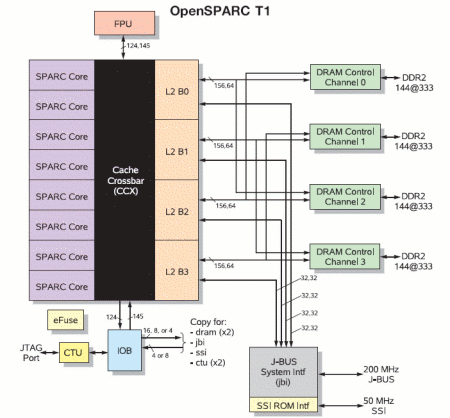Carrier Grade Linux targets Sun’s UltraSPARC T1
Nov 1, 2006 — by LinuxDevices Staff — from the LinuxDevices Archive — 3 viewsWind River has completed an “evaluation port” of its Carrier Grade Linux (CGL) stack to Sun's UltraSPARC T1, and plans to offer the industry's first commercial CGL support for the chip, by mid-2007. Wind River describes the 8-way, 64-bit processor as a “breakthrough” processor for next-generation compute-intensive communications server platforms.
Sun launched its T1 design about a year ago, concurrent with the release of Solaris 10. The 8-way processor's threading model has eight 6-stage pipelines, which combine to support up to 32 light-weight processes (LWPs), each of which can have instructions executing simultaneously, Sun said at the time.

UltraSPARC T1 architecture diagram
(Click to enlarge)
Additionally, the T1 draws about 80 Watts — roughly half the power required by equivalent Xeon or IBM Power processors, according to Sun.
Wind River's PNE-LE (Platform for Network Equipment, Linux Edition) support for UltraSPARC will target systems built on AdvancedTCA blades, including signaling and media gateways, application servers, home subscriber and location registers, and “additional components addressing the latest requirements for 3G and IP multimedia subsystem (IMS) deployments,” Wind River says. The company reports that in its UltraSPARC T1 implementation, a hypervisor runs across the eight cores, providing 32 physical threads — 28 more than any other general-purpose multi-core processor.
Sun GPL'd the T1 design in March, and earlier this month, reported significant momentum within the resulting community of open source T1 adopters. Availability of the processor design and ISA (instruction-set architecture) “greatly simplifies” development of run-time software, according to Wind River.
PNE-LE is one of only three commercially available OSes registered for compliance with the Carrier Grade Linux 3.2 specification. Wind River says PNE-LE also supports the “emerging” PICMG 3.x ATCA specification, along with “various high-availability functions.” The company also touts PNE-LE's TIPC-based interprocess communication (IPC) mechanism for interoperation with other standards-compliant RTOSes, such as VxWorks.
Raju Penumatcha, VP of Networking at Sun, stated, “The first Carrier-Grade Linux on the UltraSPARC T1 is from Wind River. Wind River is recognized for its rich development environment and reliability. Combining these attributes with the unmatched scalability of the Sun OpenSPARC architecture enables a Linux platform that is ready for the next build out of converged networks.”
John Bruggeman, chief marketing officer at Wind River, stated, “Sun's UltraSPARC delivers features that enable a whole new class of high-end, high-value solutions.”
Availability
Support for the next generation OpenSPARC processor will be available in the second half of 2007.
More details about Sun's UltraSPARC T1 are available on the company's open source website, here.
This article was originally published on LinuxDevices.com and has been donated to the open source community by QuinStreet Inc. Please visit LinuxToday.com for up-to-date news and articles about Linux and open source.